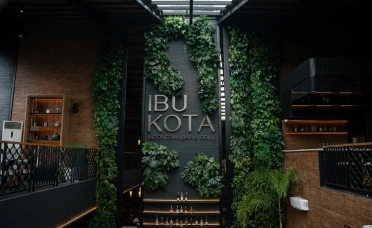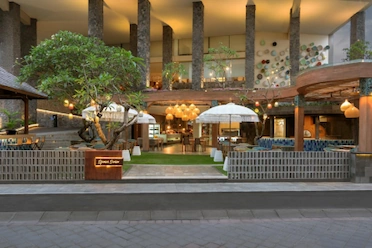Off the southeastern coast of Bali, in the calm, turquoise shallows between Nusa Lembongan and its sister island Nusa Ceningan, a quiet revolution is taking place. Every morning, as the sun begins its slow rise over the Badung Strait, the sea glitters with movement — not waves, but seaweed farmers wading through the shallows, tending to their underwater crops. These are the seaweed farmers of Nusa Lembongan, and their story is one of tradition, resilience, and an unexpected alliance between agriculture and tourism.
These are the seaweed farmers of Nusa Lembongan, and their story is one of tradition, resilience, and an unexpected alliance between agriculture and tourism.
A Tradition Born in the Tides
Seaweed farming in Nusa Lembongan began humbly in 1982 when a local brought sea moss seeds from Lombok and shared the technique with coastal communities. By 1984, with the help of a businessman from Surabaya, seaweed farming had taken root, particularly in Jungut Batu village. The clear, sun-drenched waters of the Lembongan-Ceningan channel provided ideal growing conditions for Eucheuma cottonii, a type of red algae rich in carrageenan, a highly sought-after gelling agent used in food, cosmetics, and pharmaceuticals.
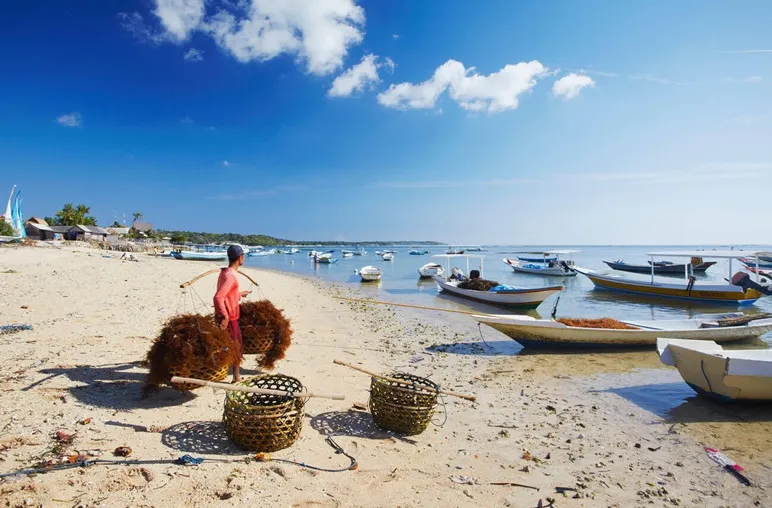
For decades, this simple yet labor-intensive livelihood sustained hundreds of families. The process is elemental: seaweed seedlings are tied to nylon ropes and anchored in shallow plots marked by bamboo stakes. Farmers, often entire families, tend to their aquatic gardens daily, harvesting every 30–45 days. After drying in the sun, each kilo fetches around IDR 14,000 (less than $1), with most of the yield sold to collectors for export.
Collapse and Revival
By 2010, however, things began to change. As Bali’s tourism sector boomed, seaweed farming began to fade. Many locals abandoned the trade for jobs in guesthouses, cafés, and diving schools. Then came 2020. When the COVID-19 pandemic hit, Bali’s tourism machine came to a screeching halt. Nusa Lembongan, once buzzing with international travelers, emptied. Livelihoods evaporated almost overnight. But for many, the sea offered a return to stability. Locals looked back to the ocean and rediscovered seaweed farming—not just as a fallback, but as a resilient, self-reliant way to survive.

What started as a necessity soon evolved into a revival. The older generation, once resigned to the disappearance of their trade, became mentors. Knowledge that had almost been lost—when to plant, how to spot pests, where to locate the most fertile waters—was passed on to the youth. By 2022, seaweed plots once overgrown or abandoned had been replanted, and the island's shoreline again transformed into a mosaic of green patches visible from the cliffs above.
The Economics of Resilience
Seaweed farming doesn’t make anyone rich—but it does offer consistency. With average monthly earnings of around $400 USD, seaweed farmers now out-earn many working in tourism-adjacent roles. In post-pandemic Bali, where economic uncertainty still looms, this matters.
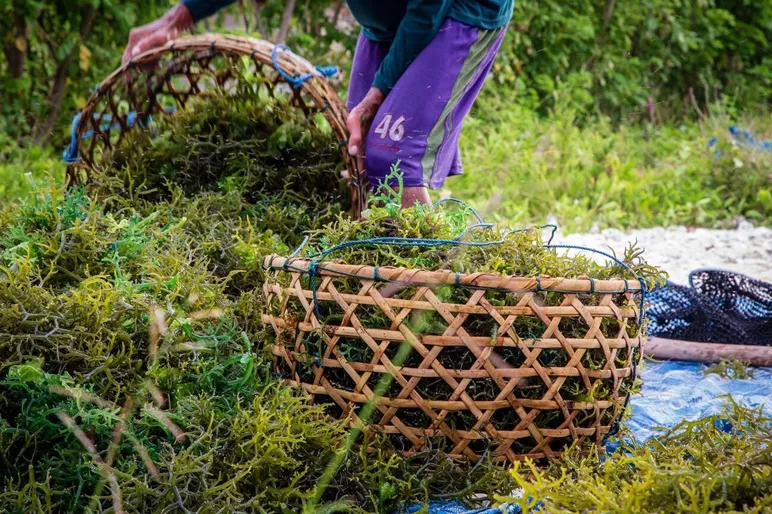
Yet, the industry remains fragile. Fluctuating market prices, pollution from ocean plastics, unpredictable weather, and lack of formal support all threaten the trade. Farmers notes that plastic debris from other parts of Indonesia — and even as far as the Philippines — frequently washes into their farming waters, endangering crops and reducing yields. Despite these challenges, seaweed farming is no longer just about survival. It’s about sustainability.
The Intersection of Farming and Tourism
Ironically, it’s tourism that may now help sustain seaweed farming. Visitors to Nusa Lembongan are increasingly drawn to the authentic cultural experiences offered by the seaweed farms. Canoes dotting the horizon, farmers tying seedlings beneath the rising sun, women drying seaweed in bundles on the beach—these are scenes that fascinate Instagram-hungry travelers seeking a glimpse of “real Bali.”
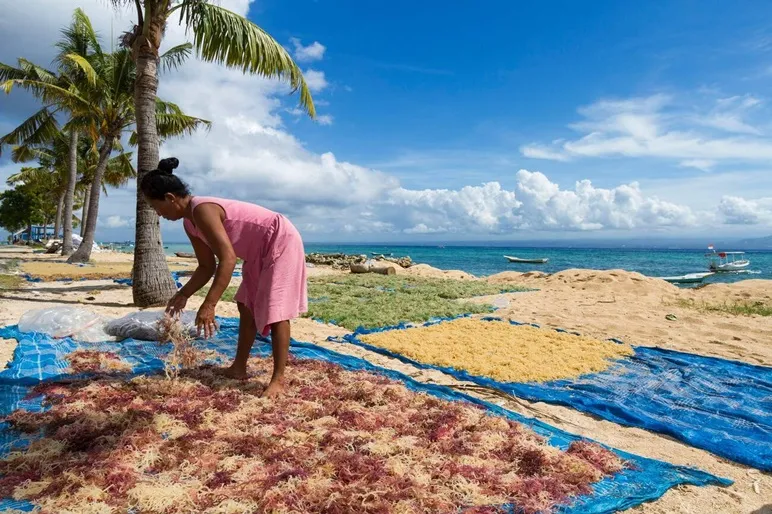
Some seaweed farmers now welcome small groups to observe their work, even offering hands-on experiences. Tour operators have integrated seaweed farms into their itineraries, pairing them with visits to natural attractions like the Mangrove Forest, Yellow Bridge, and Devil’s Tears. These partnerships not only provide farmers with supplemental income, but also position them as stewards of both marine ecology and Balinese culture.
Seaweed farming offers a compelling blueprint for economic diversification in Bali—deeply local, ecologically mindful, and increasingly appealing to modern tourists. It’s a quiet, algae-green revolution—rooted not in flashy villas or high-end resorts, but in the shallow coastal waters of Nusa Lembongan, where generations of farmers rise each morning, ankle-deep in sea and tradition.
And while the tides may shift, the resolve of these ocean gardeners remains unwavering...



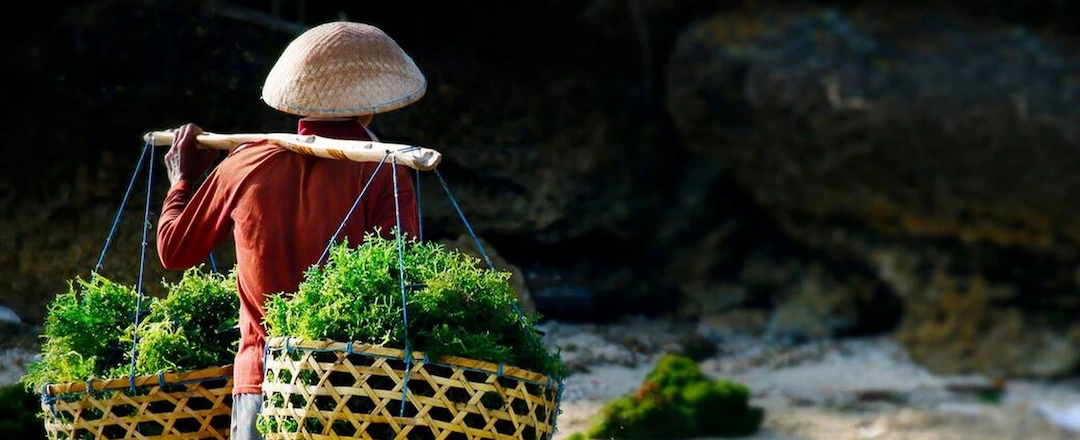
 Billy Bagus
Billy Bagus
 Jul 08, 2025
Jul 08, 2025
